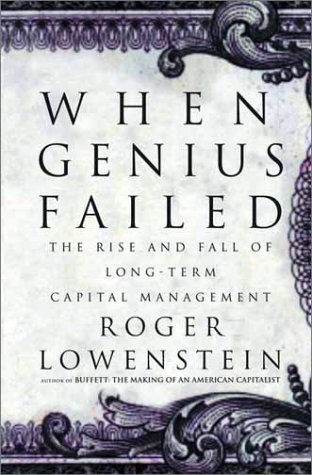More on this book
Community
Kindle Notes & Highlights
Read between
November 3 - November 15, 2022
LTCM managed money for only one hundred investors; it employed not quite two hundred people, and surely not one American in a hundred had ever heard of it. Indeed, five years earlier, LTCM had not even existed.
For four years, Long-Term had been the envy of Wall Street. The fund had racked up returns of more than 40 percent a year, with no losing stretches, no volatility, seemingly no risk at all.
it was by no means the worst of Long-Term’s problems. The fund had entered into thousands of derivative contracts, which had endlessly intertwined it with every bank on Wall Street. These contracts, essentially side bets on market prices, covered an astronomical sum—more than $1 trillion worth of exposure.
By law, funds can sign up no more than ninety-nine investors, people, or institutions each worth at least $1 million, or up to five hundred investors, assuming that each has a portfolio of at least $5 million. The implicit logic is that if a fund is open to only a small group of millionaires and institutions, agencies such as the SEC need not trouble to monitor it. Presumably, millionaires know what they are doing; if not, their losses are nobody’s business but their own.
the Efficient Market Hypothesis. The premise of the hypothesis is that stock prices are always “right”; therefore, no one can divine the market’s future direction, which, in turn, must be “random.”
Investors long for steady waters, but paradoxically, the opportunities are richest when markets turn turbulent.
If you aren’t in debt, you can’t go broke and can’t be made to sell, in which case “liquidity” is irrelevant. But a leveraged firm may be forced to sell, lest fast-accumulating losses put it out of business. Leverage always gives rise to this same brutal dynamic, and its dangers cannot be stressed too often.
Business Week gushed that the fund’s Ph.D.s would give rise to “a new computer age” on Wall Street. “Never has this much academic talent been given this much money to bet with,” the magazine observed in a cover story published during the fund’s first year.
Long-Term did not merely concede the possibility of loss, it calculated the supposed odds of its occurring, and to precise mathematical degrees. Just as a handbook of poker might tell you that the odds of drawing an inside straight were 8.51 percent, the professors calculated that Long-Term would lose at least 5 percent of its money 12 percent of the time (that is, in twelve of every hundred years). The letter went on to state the precise odds of the fund’s losing at least 10 percent, as well as 15 percent and 20 percent.¹
The point was, Long-Term predicted the odds with precision. It was as if the professors had some secret knowledge or an altered view of the world, for no ordinary investor would hazard such forecasts.
As the English essayist G. K. Chesterton wrote, life is “a trap for logicians” because it is almost reasonable but not quite; it is usually sensible but occasionally otherwise: It looks just a little more mathematical and regular than it is; its exactitude is obvious, but its inexactitude is hidden; its wildness lies in wait.5
Their total profits in 1996 were an astounding $2.1 billion.15 To put this number into perspective, this small band of traders, analysts, and researchers, unknown to the general public and employed in the most arcane and esoteric of businesses, earned more that year than McDonald’s did selling hamburgers all over the world, more than Merrill Lynch, Disney, Xerox, American Express, Sears, Nike, Lucent, or Gillette—among the best-run companies and best-known brands in American business.
Markets can remain irrational longer than you can remain solvent. —JOHN MAYNARD KEYNES
In late summer, as Wall Streeters scurried for the Hamptons, the partners were among America’s most prosperous, most successful, and most highly esteemed investors. Their fund had $3.6 billion in capital, of which two fifths was personally theirs. It would take only five weeks for them to lose it all.
Long-Term, which had calculated with such mathematical certainty that it was unlikely to lose more than $35 million on any single day, had just dropped $553 million—15 percent of its capital—on that one Friday in August.
Long-Term was helpless, a bloated whale surrounded by deadly piranhas. The frightful size of its positions put the partners in a terrible bind. If they sold even a tiny fraction of a big position—say, of swaps—it would send the price plummeting and reduce the value of all the rest.
Through April 1998, the value of a dollar invested in Long-Term quadrupled to $4.11. By the time of the bailout, only five months later, precisely 33 cents of that total remained.
In net terms, the greatest fund ever—surely the one with the highest IQs—had lost 77 percent of its capital while the ordinary stock market investor had been more than doubling his money.
If the Long-Term episode proved anything, it is that the system of disclosure that has worked so well with regard to traditional securities has not been able to do the job with respect to derivative contracts. To put it plainly, investors have a pretty good idea about balance-sheet risks; they are completely befuddled with regard to derivative risks. Some of the reporting standards are being changed (over the opposition of both Greenspan and the banks), but gaping holes remain. As the use of derivatives grows, this deficiency will return to haunt us.


